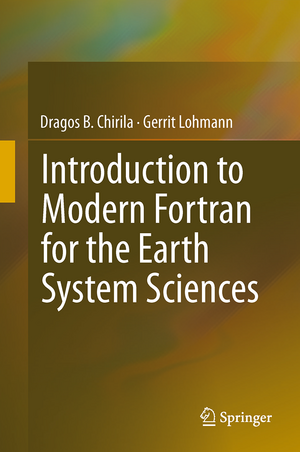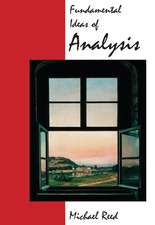Introduction to Modern Fortran for the Earth System Sciences
Autor Dragos B. Chirila, Gerrit Lohmannen Limba Engleză Hardback – 9 dec 2014
The main goal is to enable readers to quickly start using Fortran 95 for writing useful programs. It also introduces a gradual discussion of Input/Output facilities relevant for Earth system sciences, from the simplest ones to the more advanced netCDF library (which has become a de facto standard for handling the massive datasets used within Earth system sciences). While related works already treat these disciplines separately (each often providing much more information than needed by the beginning practitioner), the reader finds in this book a shorter guide which links them. Compared to other books, this work provides a much more compact view of the language, while also placing the language-elements in a more applied setting, by providing examples related to numerical computing and more advanced Input/Output facilities for Earth system sciences.
Naturally, the coverage of the programming language is relatively shallow, since many details are skipped. However, many of these details can be learned gradually by the practitioner, after getting an overview and some practice with the language through this book.
| Toate formatele și edițiile | Preț | Express |
|---|---|---|
| Paperback (1) | 639.25 lei 6-8 săpt. | |
| Springer Berlin, Heidelberg – 23 aug 2016 | 639.25 lei 6-8 săpt. | |
| Hardback (1) | 650.37 lei 6-8 săpt. | |
| Springer Berlin, Heidelberg – 9 dec 2014 | 650.37 lei 6-8 săpt. |
Preț: 650.37 lei
Preț vechi: 765.14 lei
-15% Nou
Puncte Express: 976
Preț estimativ în valută:
124.49€ • 135.27$ • 104.64£
124.49€ • 135.27$ • 104.64£
Carte tipărită la comandă
Livrare economică 21 aprilie-05 mai
Preluare comenzi: 021 569.72.76
Specificații
ISBN-13: 9783642370083
ISBN-10: 364237008X
Pagini: 60
Ilustrații: XXII, 250 p. 15 illus., 10 illus. in color.
Dimensiuni: 155 x 235 x 17 mm
Greutate: 0.69 kg
Ediția:2015
Editura: Springer Berlin, Heidelberg
Colecția Springer
Locul publicării:Berlin, Heidelberg, Germany
ISBN-10: 364237008X
Pagini: 60
Ilustrații: XXII, 250 p. 15 illus., 10 illus. in color.
Dimensiuni: 155 x 235 x 17 mm
Greutate: 0.69 kg
Ediția:2015
Editura: Springer Berlin, Heidelberg
Colecția Springer
Locul publicării:Berlin, Heidelberg, Germany
Public țintă
GraduateCuprins
1 General concepts.- 2 Fortran Basics.- 3 Elements of software engineering.- 4 Applications.- More advanced techniques.- 5 More advanced techniques.
Textul de pe ultima copertă
This work provides a short "getting started" guide to Fortran 90/95. The main target audience consists of newcomers to the field of numerical computation within Earth system sciences (students, researchers or scientific programmers). Furthermore, readers accustomed to other programming languages may also benefit from this work, by discovering how some programming techniques they are familiar with map to Fortran 95.
The main goal is to enable readers to quickly start using Fortran 95 for writing useful programs. It also introduces a gradual discussion of Input/Output facilities relevant for Earth system sciences, from the simplest ones to the more advanced netCDF library (which has become a de facto standard for handling the massive datasets used within Earth system sciences). While related works already treat these disciplines separately (each often providing much more information than needed by the beginning practitioner), the reader finds in this book a shorter guide which links them. Compared to other books, this work provides a much more compact view of the language, while also placing the language-elements in a more applied setting, by providing examples related to numerical computing and more advanced Input/Output facilities for Earth system sciences.
Naturally, the coverage of the programming language is relatively shallow, since many details are skipped. However, many of these details can be learned gradually by the practitioner, after getting an overview and some practice with the language through this book.
The main goal is to enable readers to quickly start using Fortran 95 for writing useful programs. It also introduces a gradual discussion of Input/Output facilities relevant for Earth system sciences, from the simplest ones to the more advanced netCDF library (which has become a de facto standard for handling the massive datasets used within Earth system sciences). While related works already treat these disciplines separately (each often providing much more information than needed by the beginning practitioner), the reader finds in this book a shorter guide which links them. Compared to other books, this work provides a much more compact view of the language, while also placing the language-elements in a more applied setting, by providing examples related to numerical computing and more advanced Input/Output facilities for Earth system sciences.
Naturally, the coverage of the programming language is relatively shallow, since many details are skipped. However, many of these details can be learned gradually by the practitioner, after getting an overview and some practice with the language through this book.
Caracteristici
Written from a strongly applied perspective Describes more advanced Input/Output facilities (netCDF) than competing works, linked with numerical applications Concise introduction to Fortran 95 programming for the targeted reader Includes supplementary material: sn.pub/extras




















